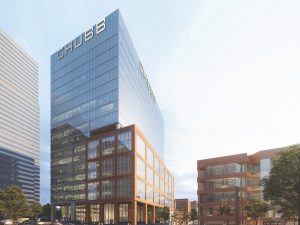A Broker’s View of the Philly Office Market
The Flynn Co.’s Michael Gallagher discusses shifts, trends, and challenges in the northeastern market.
The Philadelphia commercial real estate market has changed significantly in the past two decades. Events such as 9/11, the Great Recession and, most recently, the health crisis have all left their mark. Today, just like in most parts of the country, the metro’ office market is under a lot of pressure.
“A substantial amount of additional vacancy is anticipated as companies continue to downsize and scale back their footprint,” said The Flynn Co. Partner Michael Gallagher. However, both investors and tenants continue to eye quality assets in Philly’s urban core.
The Flynn Co. is one of the largest and oldest commercial real estate brokerage companies in Greater Philadelphia, having facilitated $3 billion in sales and lease transactions in the past 10 years alone. Commercial Property Executive asked Gallagher to talk about all the shifts he has seen in the metro’s office market and provide perspective on what might lie ahead.
READ ALSO: East Coast Office Sector Trends
How would you describe Philly’s office market today?
Gallagher: The Center City Philadelphia office market is still trying to recover post-COVID-19 and determine its future within the current work-from-home environment. As is the case with the national office market, a lot of uncertainty remains as tenants try to figure out if and when they are going to return to the office, how many days per week, and at what percentage of their pre-pandemic footprint they will occupy.
While small- and medium-sized deals—2,000 to 20,000 square feet—are getting signed, it is at a much slower pace, and larger tenants—north of 20,000 square feet—are mostly stuck in neutral. Since 2019, less than 10 lease transactions greater than 50,000 square feet have been signed across the city.
Are there any areas of the metro that are more sought-after than others?
Gallagher: Within the core of Center City, there definitely has been a “flight to quality” towards Class A and Class A+ office buildings as tenants take advantage of the volatility in the market. Most of the larger tenants that are relocating are downsizing between 15 percent to 20 percent of their existing space. Due to that rental savings, companies can justify paying a slightly higher rent in a much nicer building. Additionally, Class A landlords have been redeploying their capital and investing back into their buildings, and are now delivering much better amenities and efficiencies for these tenants.
The same flight-to-quality dynamics apply to the smaller and medium-sized firms that are taking advantage of relocating to nicer properties, but a lot of those companies are seeking out less traditional and creative four-to-six-story buildings. Firms feel it is “less stuffy” for their employees. This is an interesting trend that could continue to serve as a bridge between working from home and full-time office occupancy.

Rendering of Chubb’s upcoming 438,000-square-foot office building at 2000 Arch St. Image courtesy of Chubb
There is a widespread embrace of hybrid and fully remote working models. To what extent has this trend left its mark on Philly’s office market?
Gallagher: Both the hybrid office working model and full-remote working model have had a significant and ongoing impact on Center City’s office market. A hybrid model of three to four days per week seems to be the evolution of the market with organizations like Comcast and local law firms embracing and encouraging the model for their employees. Full-remote work still seems to be in the experimentation stage as fewer firms are now going full work from home. There is no “normal” yet as office space dynamics differ from industry to industry, firm to firm and employee to employee.
How has office vacancy fluctuated in the past 12 months across the metro?
Gallagher: The ongoing uncertainty in the economy and future of the workplace has had a significant impact on Center City’s office fundamentals. Through the third quarter of 2022, there was -750,000 square feet of net absorption in the market. The vacancy rate increased to 17.6 percent and the market continues to get flooded with sublease space, with over 2.5 million square feet of either direct sublet and/or “shadow space” coming back. Rental rates have remained mostly consistent with an average of $34.02 per square foot, buoyed in large part by the historically high cost of construction.
But in spite of these increasing construction costs, Philadelphia’s pipeline of proposed billion-dollar-plus projects is still robust. How is all this construction activity impacting the metro’s urban core?
Gallagher: From the health of an office market perspective, all new construction will have a very positive impact for Center City. Most promising and a silver-lining in the current market are the two new ground-up office buildings built/proposed by Parkway Corp. Morgan Lewis is preparing to move into their new 305,170-square-foot headquarter property at 2222 Market St. early this year. Additionally, Parkway is finalizing negotiations to develop a new 475,000-square-foot headquarters building for insurance giant Chubb at 20th & Arch Street. Two new ground-up office developments coming online during and just after the pandemic is a phenomenal sign for the future of Center City and will help solidify the market’s foundation moving forward.
New residential construction continues to get built along North Broad Street and other burgeoning areas of the city, which helps bring new potential employees and tenants to the area. The success of the life science/biotech market in University City has been a great jolt of development, as well. Should the Sixers prove successful in developing their new arena along East Market Street, that would be a transformational project for that immediate area and the future of Center City.
You’re a Philadelphia native, with a very solid background in the metro’s commercial real estate market. How much has the metro’s CRE market changed since you started off in this business?
Gallagher: I started with The Flynn Co. and in the commercial real estate business in the summer of 1999, so there have been many changes, cycles, and shifts in those 24 years. After 9/11, the office market and high-rise development was predicted to be wiped out and the fundamentals withstood that cycle, as well as the 2008 market crash. I think this market shift will be more significant since it’s a fundamental workplace change, but I remain extremely confident it will rebound yet again.
Technology is also at the top of the list. In addition to the obvious, its impact on the brokerage business, relationships and services that commercial real estate firms are now able to provide has been monumental. Commercial real estate has also thankfully finally started to gain steam and traction with its elusive diversification numbers with more female and minority brokers in the business.
What are your expectations for Philly’s office market this year?
Gallagher: In the immediate 12-month stretch, I think the Center City office market will continue to experience negative net absorption. There are approximately 3 million square feet of leases rolling in the next year along the West Market corridor alone and this will have an additional negative impact on vacancy rates and eventually start to compress rental rates. There will continue to be a flight to quality, so there will be deal volume but the overwhelming majority of signings will be considered a reduction in space.
Many are turning to office buildings getting converted to residential to solve the negative absorption issue, but with 10 million square feet of office buildings already converted since 2000, cost to convert and a lack of available supply are a concern. Along with these market trends, it will also be important to track the effect increased interest rates will have on landlords’ balance sheets.
The Philadelphia and Center City market will rebound as robust as ever, though. There will be stronger leadership and safety measures in place, and the strength and foundation of the city will be led by its many health-care and educational/institutional organizations, its location, amenities, and infrastructure.









You must be logged in to post a comment.